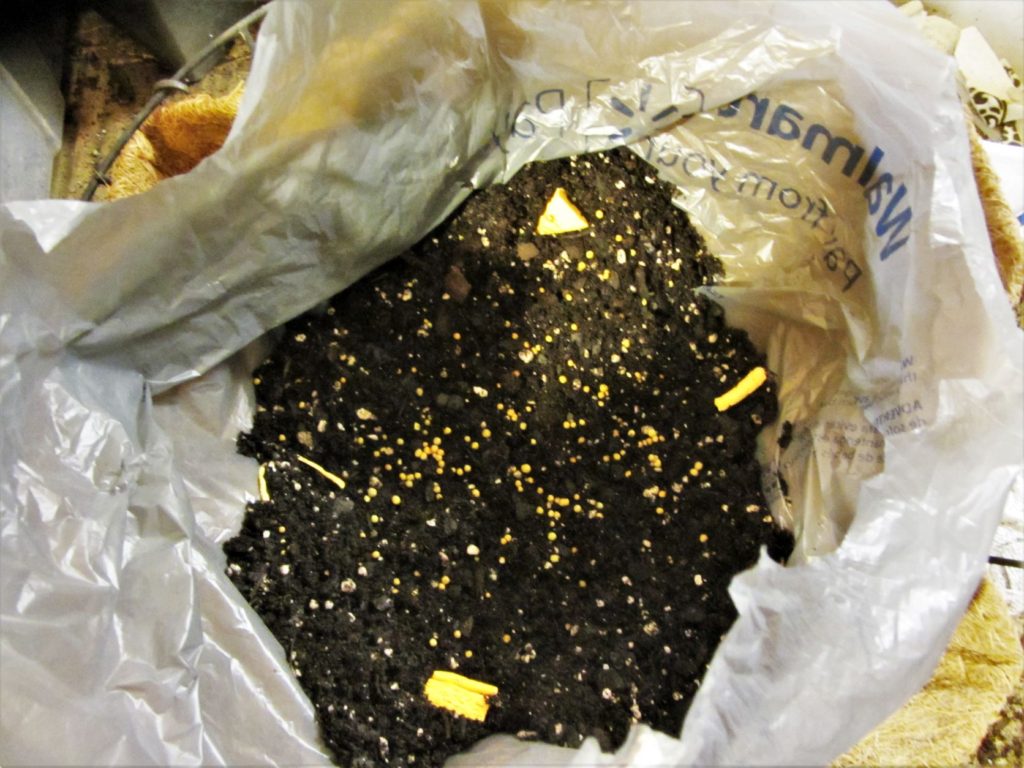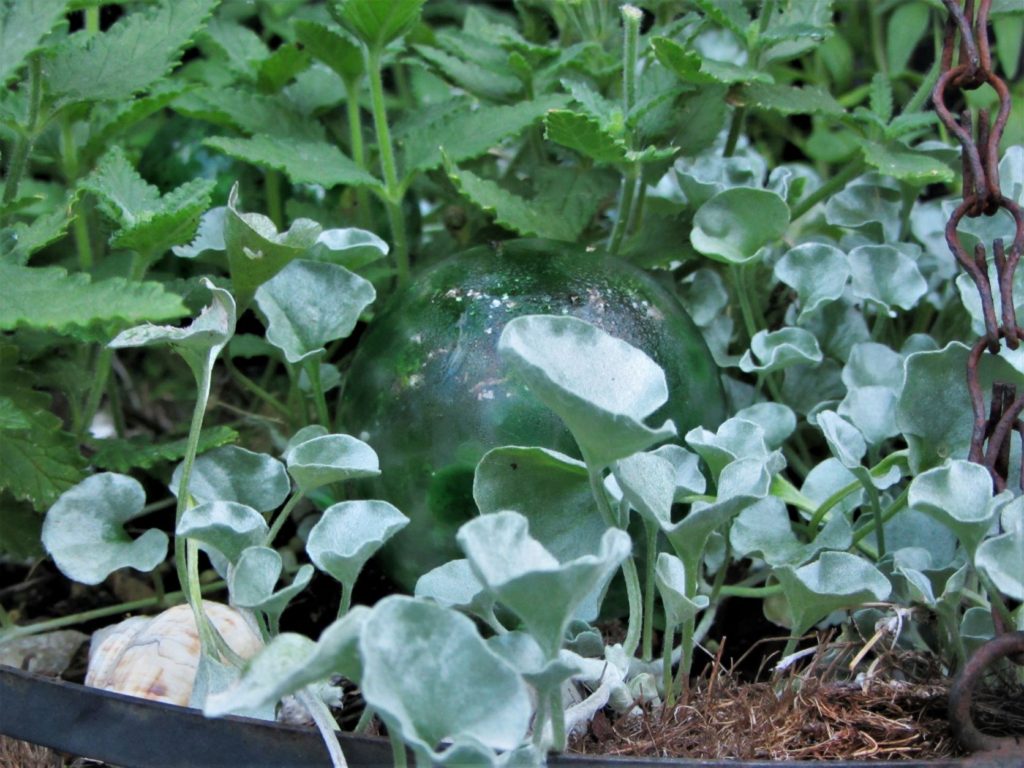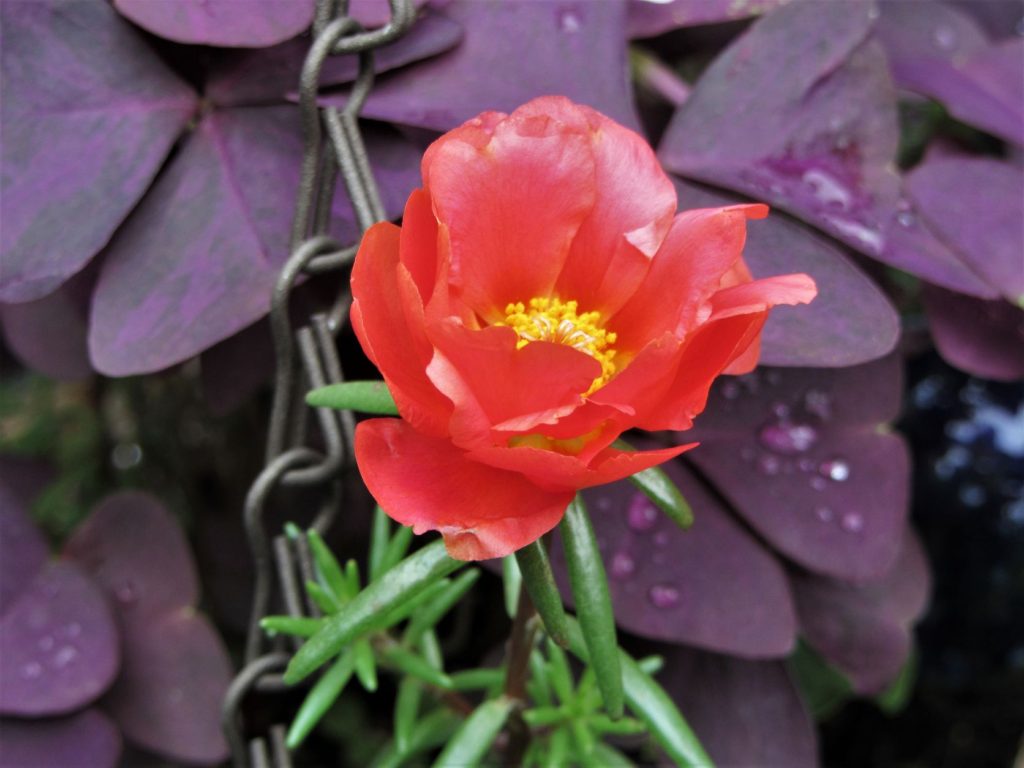Water-wise Design for Hanging Baskets

Euphorbia ‘Diamond Frost,’ ivy geraniums, hybrid Verbena and Dichondra perform well in a sunny hanging basket. Tradescantia pallida, in the adjoining basket, is exceptionally drought tolerant.
Do you have a hanging basket that is struggling in summer’s heat? Do you have plants under-performing because you can’t keep their container sufficiently watered?
The Hydration Equation
Keeping plants supplied with water and nutrients is an ongoing challenge with any container planting, especially with baskets and window boxes. Plants require water and nutrients for strong growth an abundant flowers. A hanging basket is an extreme environment for many plants. Baskets will dry out quickly on a scorching, sunny summer day. There is rarely enough rain to sustain them, and watering can get messy.
Here are some simple and inexpensive hacks to conserve water and make your basket more comfortable for living, blooming plants.
Choose Wisely
Begin with the largest basket your space, and the support it will hang from, can accommodate. Larger baskets mean more soil to hold moisture, and more space for roots to grow. A 14″-16″ basket is a good size to work with. If you are working with a window box rather than a basket, look for ones at minimum 6″ deep.
I prefer wire baskets with a coco or coir liner. Even baskets watered in early morning may dry out by mid-afternoon on a windy day. Coir makes a better liner than the traditional sphagnum moss, but still is porous.

Line the basket with recycled plastic. Poke a few drainage holes in the plastic along the bottom edge of the liner. A new dry sponge, cut into small pieces, helps absorb available water and will release it later, as needed. Recycle cleaned, used kitchen sponges for this purpose, too.
Hydration Hacks
Line the basket with a plastic liner to aid water retention. Use a large plastic dry cleaner bag or a similar light-weight sheet of plastic. Poke a few holes for drainage, and let the plastic overhang the basket by several inches. You may need to cut or fold the plastic before it will lie smoothly against the sides of your liner.
Improve water retention with a cellulose kitchen sponge. Cut a clean sponge into small pieces. Place most of them in the bottom of the basket between the plastic liner and the soil. Partially fill the liner with potting mix, and then add a few more fragments of sponge around the outside edge of the basket.

Add bits of sponge in lower layers of the potting mix, particularly near any drainage holes in the liner. Osmocote slow-release fertilizer has also been added to the potting mix.
The sponges serve as little reservoirs, soaking up excess water when it is available, and releasing it later when it is needed. Place several sponge fragments around drainage holes in the liner, to soak up water before it drains out.
Use good, fresh potting mix and add some slow-release fertilizer like Espoma’s Plant Tone or Osmocote. Plants need nutrients while actively growing and blooming. Most potting mixes are sterile, without the nutrients commonly found in living garden soil. Garden soil is too dense and heavy for a hanging basket or window box, so adding slow-release fertilizer helps bring out the best performance in your plants. Additives like perlite, shredded bark and bonsai mix also absorb water and help aerate the mix. Water retaining polymer crystals are available to make soil even more water retentive. Prepare enough amended potting mix, in a separate container, to fill the basket.
Fill your lined basket about half full of fresh potting mix and then begin placing plants. Scoop some mix around the roots of each one as you work. Rooted cuttings, bulbs, corms and rhizomes can be planted in established basket arrangements to refresh and update them. They are easier to add than potted nursery plants, since they have smaller roots. Keep them well watered as they grow in.
Some designers want plants growing through the liner to give the basket a fuller look. Use a knife to slice an opening through the coir and plastic liners, then gently work a plant through the opening so that it lies horizontally to the soil. Carefully cover the roots as you continue planting.
Choose Tough Plants for Tough Locations
Choose drought tolerant plants for your basket plantings. Succulents, like Portulaca or Sedums, can absorb and store water when it is available and then go for a long time without additional watering. Succulents have a waxy coating on the epidermis of each leaf and stem to reduce evaporation.
Other good plant choices include:
For Sun: Pelargoniums (Zonal, ivy or scented geraniums), Lantana, Tradescantia, Plectranthus, Dichondra, Euphorbia, Agastache, Artemesia, Salvia, and many herbs. Mediterranean herbs, like rosemary and thyme, also have a waxy epidermis to conserve moisture.
For Part Sun or Shade: Begonias, Coleus, Calaldiums, Verbena, Oxalis, Alyssum, and sun-tolerant ferns
Plant that require consistently moist soil may struggle in baskets and window boxes when the weather turns hot, dry and sunny. Some of our favorite hanging baskets flowering plants, like petunias and impatiens, may not hold up to summer weather without very frequent watering.

Water globes help keep soil hydrated when you’re away. Here, with Dichondra ‘Silver Falls’ and hybrid Verbena
Finishing Touches
Finish your newly planted basket with a mulch. Bare soil loses moisture faster than mulched soil. Good mulches in our climate are fine gravel, like aquarium gravel, bonsai mix or pea gravel. Other choices include larger stones, small seashells, flat glass beads, marbles or glass chips, and moss for baskets that grow in shade. Not only will mulch reduce evaporation, but it will also prevent potting mix from splashing up on plants, to keep them clean and healthy. Mulch cools the basket and provides some protection against digging squirrels or curious birds.
Once the basket is planted, with potting soil worked in firmly around all of the roots, trim the plastic liner, add the mulch, and then water the basket well. Let perhaps an inch of plastic extend above the soil line, then fold it over and hold it in place with the mulch materials. Water the basket with plain water first to settle and hydrate the soil. Then water again with a foliar feed of diluted fish and seaweed emulsion to help the plants adjust and to provide trace minerals to the soil.
In spring, you can hang the basket in its permanent place right away. A stretch of cloudy, wet weather is best for a new basket. In summer, allow a day or two for the plants to settle in and adjust in the shade before moving the basket to a sunny location.
Watering globes help keep baskets evenly hydrated because they deliver water deep in the basket, near thirsty roots. Fill the globe when empty, and water will seep into the potting mix as needed. Baskets in full sun benefit from this extra care.
Emergency First Aid
We all have a basket dry out from time to time. Potting mix is very hard to moisten once it is dry, and our plants may wilt and turn brown.
These steps might still save your planting:
- Take the basket down, move it to a shady place, and set the entire basket in a larger, waterproof container. Water well, and allow the basket to sit in a few inches of water while the soil re-hydrates and the plants revive.
- Carefully trim away all wilted flowers and any leaves or stems that are brown. Prune plant stems back by 1/2 to 1/3, to just above a leaf node. This will reduce stress and stimulate new growth. Cut back any plants that look dead to an inch or two. They may re-grow from their roots.
- Once the soil is re-hydrated and the plants have recovered their firmness and color, give a diluted foliar feed with fish and seaweed emulsion, to help them recover and to stimulate new growth.
- Give your basket a day or two hanging in partial shade, or wait for a cloudy day, and then return the basket to its usual place.

Succulent Portulaca comes in a wide variety of colors and flower forms. Stems root easily, and a single plant can yield dozens of rotted cuttings.
It requires attention and consistent effort to keep a hanging basket beautiful. Regular grooming, fertilizing, and watering keep the plants in top shape. Success begins with proper preparation and plant selection. The more realistic we are about our specific growing conditions, the better chances our plantings will last and bring pleasure throughout the season.
All Photos by E. L. McCoy



